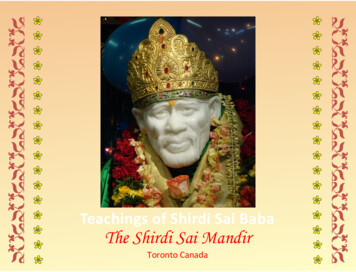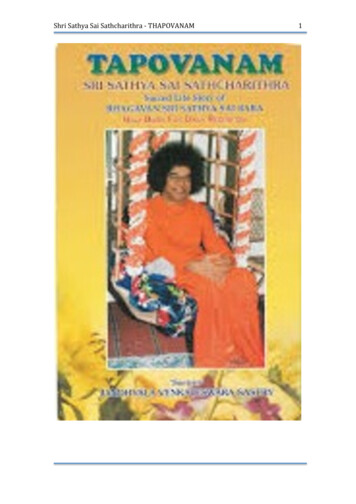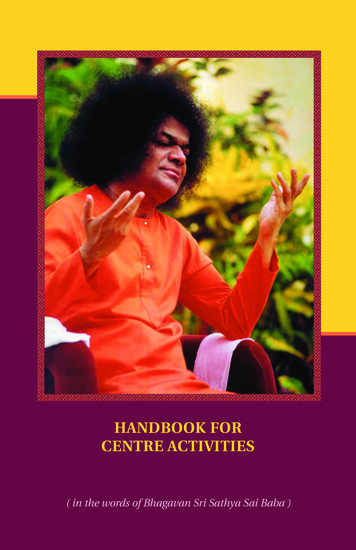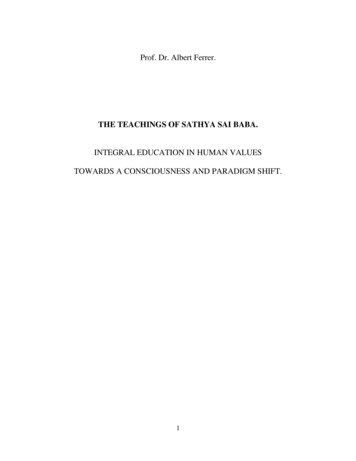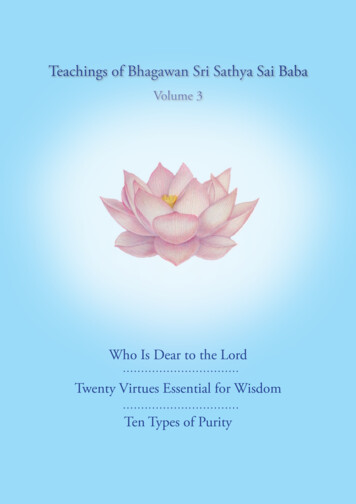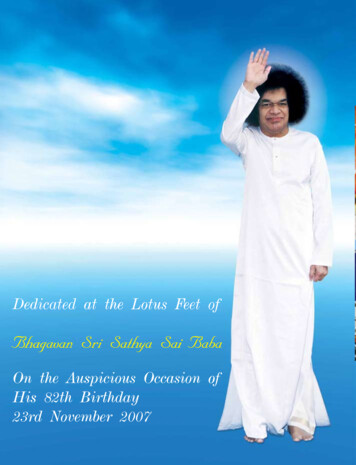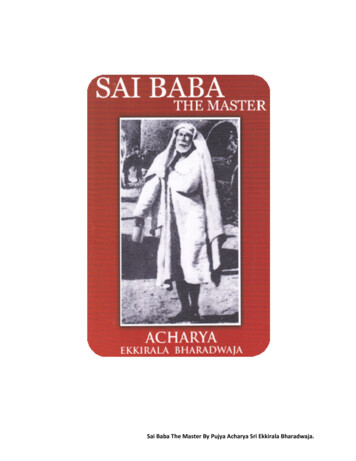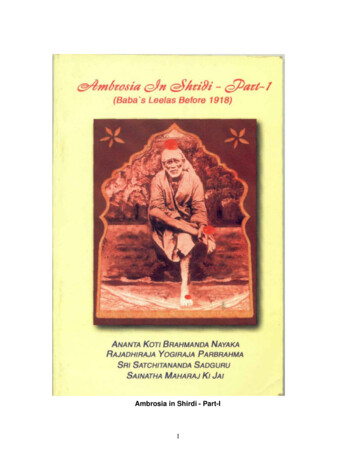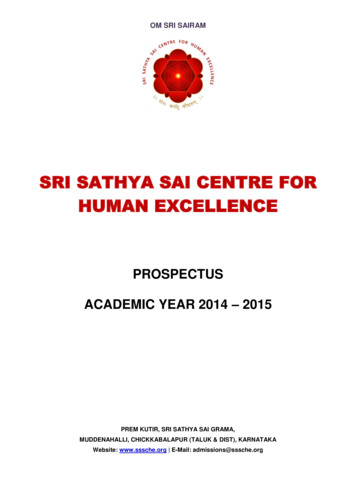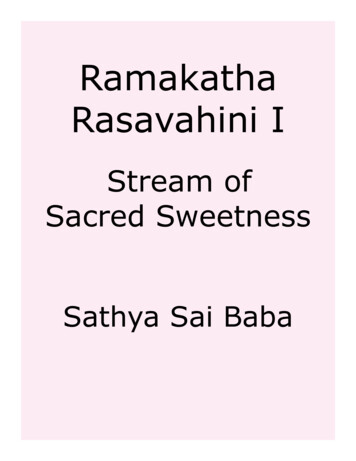
Transcription
RamakathaRasavahini IStream ofSacred SweetnessSathya Sai Baba
ContentsRamakatha Rasavahini I 7Publisher’s Note 8This Book 9The Inner Meaning 11Chapter 1. Rama—Prince and Principle 12The role of sages in royal courts 13Rama’s story is the story of the universe 15Chapter 2. The Imperial Line: Raghu 16The curse of the sacred cow 17Emperor Raghu’s ideal rulership 18King Aja 19The secret of Indumathi’s death 20Chapter 3. Curse of No Progeny for Dasaratha 22The envy of Ravana 22Dasaratha’s three queens: Kausalya, Sumitra, and Kaika 23Performance of a sacrifice for begetting a son 24Chapter 4. Birth of Dasaratha’s Four Sons 27The naming ceremony 28Unhappiness at separation 29Kausalya’s experience with Rama 31The four sons grow close together 32Chapter 5. The Guru and the Pupils 34The pilgrimage 36The boys are transformed after the pilgrimage 38Rama exhibits profound wisdom 40Chapter 6. The Call and the First Victory 42The lesson for the world 47Siva’s hermitage 48The story of Malada and Karosa 49Rama kills Thataki 51Viswamitra offers Rama his weapons 53Viswamitra performs the religious rite 54Chapter 7. Winning Sita 57The story of Siva’s bow 57Viswamitra vacates his ashram 58Sage Viswamitra’s story 59The story of the Ganga 60Diti, Aditi, and the city of Visala 65A short stay in Visala 68Rama rescues Ahalya 68The city of Mithila 70Breaking the Siva-bow 73Dasaratha is invited 75Dasaratha in Mithila 77
Narrating the dynasties 78Four weddings are proposed 80The four weddings 81Taking leave 83Chapter 8. Another Challenge to Rama’s Prowess 86Home at last 90Chapter 9. Preparations for Rama’s Coronation 92Rama’s qualities 92Dasaratha decides to give up the throne 93Chapter 10. Kaika’s Two Boons 98Manthara schemes 98Kaika succumbs 100Kaika asks for the boons 101Kaika and Dasaratha argue 105Sumanthra is perplexed 111Chapter 11. Lakshmana Goes with Rama 113Rama talks to Kaika 113Rama talks to Kausalya 117Lakshmana enters the argument 120Chapter 12. Sita Insists on Going with Rama 127Chapter 13. Entering into Exile 134The journey begins 136Chapter 14. Into the Forest 138Guha, chief of the Nishadas 141Sumanthra is sent back to Ayodha 144The boatman’s ecstacy 147Guha pleads to stay with Rama 148Chapter 15. Among Hermitages 150The hermitage of Bharadwaja 150The city of Amaravathi 151The hermitage of Valmiki 152Residing on Chitrakuta Hill 154Chapter 16. Gloom over Ayodhya 157Sumanthra reaches home 157Sumanthra describes his journey 158The curse on Dasaratha 160Dasaratha passes away 162Bharatha and Satrughna return 162Bharatha learns of Dasaratha’s death 163Dasaratha’s body is cremated 166Bharatha learns the full truth 166Bharatha talks to Kausalya 168Kaika repents 169Chapter 17. The Brothers Meet 171Guha, chief of the Nishadas 172The hermitage of Bharadwaja 175On to Chitrakuta Hill 178The brothers meet 179
Discussions about returning to Ayodha 181Kaika pleads for forgiveness 185Rama orders Bharatha to return to Ayodha 186Sunayana talks to the queens and Sita 186Bharatha’s Well 189Chapter 18. Sandals Enthroned 191Taking leave 192Reaching Ayodhya 194Bharatha renounces the luxurious life 195Glossary 197
Ramakatha Rasavahini IStream of Sacred SweetnessSRI SATHYA SAI SADHANA TRUSTPublications DivisionPrasanthi Nilayam - 515134Anantapur District, Andhra Pradesh, IndiaSTD: 08555 : ISD : 91-8555 Phone: 287375, Fax: 287236Email: enquiry@sssbpt.org URL www.sssbpt.org Sri Sathya Sai Sadhana Trust, Publications Division, Prasanthi Nilayam P.O. 515 134, Anantapur District, A.P.(India.)All Rights Reserved.The copyright and the rights of translation in any language are reserved by the Publishers. No part, passage, textor photograph or Artwork of this book should be reproduced, transmitted or utilised, in original language or bytranslation, in any form or by any means, electronic, mechanical, photo copying, recording or by any information,storage and retrieval system except with the express and prior permission, in writing from the Convener, Sri SathyaSai Sadhana Trust, Publications Division, Prasanthi Nilayam (Andhra Pradesh) India - Pin Code 515 134, exceptfor brief passages quoted in book review. This book can be exported from India only by the Publishers - Sri SathyaSai Sadhana Trust, Publications Division, Prasanthi Nilayam, India.International Standard Book Number for paper edition 81-7208-300-9: ISBN for this ebook edition will come laterFirst Edition: July 2010This e-book Edition: 2014Published by:The Convener,Sri Sathya Sai Sadhana Trust,Publications DivisionPrasanthi Nilayam, Pincode 515 134, IndiaSTD: 08555 ISD: 91-8555 Phone: 287375 Fax: 287236
Publisher’s NoteThis edition of Ramakatha Rasavahini improves on the previous edition. Grammatical errors and typos havebeen corrected, and some sentences have been rewritten to smooth and clarify the presentation —of course,without disturbing the meaning. Long paragraphs have been split in two to provide easier reading.Sanskrit words have been replaced by English equivalents, to make the text accessible to readers who do notknow Sanskrit. The accuracy of the text has been maintained by putting Sanskrit words in parentheses, after theirEnglish translations.Several Sanskrit words have made their way into the English language and can be found in most dictionaries—e.g. dharma, guru, yoga, and moksha. These words are mostly used without translation, although their meanings appear in the glossary at the end of the book.Besides definition of Sanskrit words used in this book, the glossary contains descriptions of the people andplaces mentioned.This edition is being brought out in ebook form, for tablets such as the Kindle, Ipad, and Nook. Clicking onmost Sanskrit words, people, and places will take you right to the glossary, where you can find the meaning. Aback-button will be available in your reader to take you back to where you were reading.And on these tablets, you generally get to choose a font and font size that suits you.With these changes, we hope that the revised Ramakatha Rasavahini will be of great benefit to earnest seekers in the spiritual realm.ConvenerSri Sathya Sai Books and Publications TrustPrasanthi Nilayam Pin 515134, India.
This BookThis For millions of men, women, and children, The Rama Story, Stream of Sacred Sweetness, has been formany centuries the perennial source of solace during sorrow, vitality when floored by vacillation, illumination while confounded, inspiration in moments of dejection, and guidance while caught in quandaries. It is anintensely human drama in which God impersonates man and gathers around Him, on the vast world stage, theperfect and the imperfect, the human and the subhuman, the beast and the demon, to confer on us, by precept andexample, the boon of Supreme Wisdom. It is a story that plays its tender fingers on the heartstrings of people,evoking lithe, limpid responses of pathos, pity, exultation, adoration, ecstasy and surrender, rendering us transformed from the animal and the human into the Divine, which is our core.No other story in human history has had such a profound impact on the mind of people. It transcends themilestones of history and the boundaries of geography. It has shaped and sublimated the habits and attitudes ofgenerations. The Ramayana, the Story of Rama, has become a curative corpuscle in the blood stream of mankindover vast areas of the globe. It has struck root in the conscience of peoples, prodding and prompting them alongthe paths of truth, righteousness, peace, and love.Through legends and lullabies, myths and tales, dance and drama, through sculpture, music, painting, ritual,poetry and symbol, Rama has become the breath, the bliss, the treasure of countless spiritual seekers. The characters in the Rama Story have invited them to emulation and to be elevated themselves. They have provided shiningexamples of achievement and adventure. They have warned the wavering against vice and violence, pride, andpettiness. They have encouraged them by their fidelity and fortitude. To every language and dialect that the tongueof man has devised for the expression of his higher desires, the Story of Rama has added a unique, sustainingsweetness.Sai (Isa, God), whose thought is the universe, whose will is its history, is the author, director, actor, witness,and appraiser of the Drama that is ever unfolding in time and space. He has now deigned to tell us Himself thestory of this one epic act in that Drama, wherein He took on the Rama role. As Rama, Sai instructed, inspired,invigorated, corrected, consoled, and comforted His contemporaries in the Thretha Age. As Sai Rama, He is nowengaged in the same task. Therefore, most of what the readers of Sanathana Sarathi perused month after month(during these years) with ardour and pleasure, as instalments of this narrative —the Ramakatha Rasavahini—must have appeared to them “contemporary events and experiences”, and “direct counsel to them in the contextof contemporary problems and difficulties.” While reading these pages, readers will often be pleasantly struck bythe identity of the Rama of this story and the Sai Rama they are witnessing.“Science” has moulded this earth into the compactness and capsularity of a spaceship in which mankind hasto live out its destiny. “Sai-ence” is, we know, fast moulding this spaceship into a happy home of Love. This bookmust have been willed by Sai as a paramount panacea for the removal of the ills that obstruct that Universal Love—the morbid itch for sensual pleasure, the mounting irreverence toward parents, teachers, elders, spiritual leaders, and guides, the disastrous frivolity and flippancy in social, marital, and familial relationships, the demonicreli-ance on violence as a means of achieving immoral ends, the all-to-ready adoption of terror and torture asmeans of gaining personal and group gains, and many more evils besides.Sai Rama has recapitulated herein, in His own simple, sweet, and sustaining style, His own divine Career as
Rama! What great good fortune to have in our hands, to inscribe on our minds, to imprint on our hearts this divinenarrative! May we be processed by the study of this book into efficient and enthusiastic tools for consummatingHis mission of moulding mankind into One Family, of making each one of us realise Sai Rama as the Reality, theonly Reality that IS.Sai has declared that He is the same Rama come again and that He is searching for His erstwhile associatesand workers (bantu, as He referred to them, in Telugu) in order to allot them roles in His present mission of resuscitating righteousness and leading humanity into the haven of peace. While ruminating over the first half of thisStory, let us pray that we too be allotted roles, and may He grant us, as reward, the vision of that haven.N. KasturiEditor, Sanathana Sarathi
The Inner MeaningRama is the Indweller in every body. He is the Atma-Rama, the Rama (Source of Bliss) in every individual.His blessings upsurging from that inner spring can confer peace and bliss. He is the very embodiment ofdharma, of all the codes of morality that hold mankind together in love and unity. The Ramayana, the Rama story,teaches two lessons: the value of detachment and the need to become aware of the Divine in every being. Faithin God and detachment from objective pursuits are the keys for human liberation. Give up sense objects, and yougain Rama. Sita gave up the luxuries of Ayodhya so she could be with Rama, in the period of “exile”. When shecast longing eyes on the golden deer and craved for it, she lost the presence of Rama. Renunciation leads to joy;attachment brings about grief. Be in the world, but not of it.Each brother, comrade, companion, and collaborator of Rama is an example of a person saturated withdharma. Dasaratha is the representative of the merely physical, with the ten senses. The three qualities (gunas)—serenity, activity, and ignorance (sathwa, rajas, thamas)— are the three queens. The four goals of life, the purusharthas —i.e. righteousness, riches, fulfilment, and liberation— are the four sons. Lakshmana is the intellect;Sugriva is discrimination (viveka); Vali is despair; and Hanuman is the embodiment of courage.The bridge is built over the ocean of delusion. The three Rakshasa chiefs, Ravana, Kumbhakarna, and Vibhishana, are personifications of the active (rajasic), ignorant (thamasic), and pure (sathwic) qualities. Sita is theAwareness of the Universal Divinity (Brahma-jnana), which the individual must acquire and regain while undergoing travails in the crucible of life.Make your heart pure and strong, contemplating the grandeur of the Ramayana. Be established in the faiththat Rama is the Reality of your existence.—Baba
Chapter 1. Rama—Prince and PrincipleThe name Rama is the essence of the Vedas; the story of Rama is an ocean of milk, pure and potent. It can beasserted that no poem of equal grandeur and beauty has emerged from other languages or from other countries until this very day, and it has provided inspiration to the poetic imagination of every language and country.It is the greatest treasure inherited by their good fortune by every Indian.Rama is the guardian deity of the Hindus; the name is borne by the bodies in which they dwell and the buildings in which those bodies dwell. It can safely be said that there is no Indian who has not imbibed the nectar ofRamakatha, the story of Rama.The Ramayana, the epic that deals with the story of the Rama incarnation, is a sacred text. It is reverentlyrecited by people with all varieties of equipment, the scholar as well as the ignoramus, the millionaire as well asthe pauper. The name glorified by the Ramayana cleanses all evil and transforms the sinner; it reveals the formrepresented by the name, the form that is as charming as the name itself.The azure ocean and the almighty Lord have much in common. Just as the sea is the source of all the waterson earth, all beings are born from “Rama”. A sea without water is unreal; a being without “Rama” is without existence, now or ever.The ocean is the abode of the Almighty, as myth and legend proclaim; they describe Him as reclining on theocean of milk. This is the reason behind the title of each canto (kanda) given by Valmiki (son of Prachetas), thegreat poet who composed the epic.Kanda means water, an expanse of water. Kanda also means “sugar cane”. However crooked a cane maybe, whichever section you chew, the sweetness is unaffected and uniform. The stream of Rama’s story meandersthrough many a curve and twist, but the sweetness of compassion (karuna), tenderness, and pity persists withoutdiminution throughout the narrative. The stream turns and flows through sadness, wonder, ridicule, awe, terror,love, despair, and dialectics, but the main undercurrent is the love of dharma and the compassion it fosters.The nectar in the story of Rama is as the Sarayu river, which moves silently by the city of Ayodhya, whereRama was born and ruled. The Sarayu has its source in the Himalayan Lake of the Mind (Manasa-Sarovar), justas this story is born in the lake of the mind! The Rama stream bears the sweetness of compassion; the stream ofLakshmana (Rama’s brother and devoted companion) has the sweetness of devotion. Just as the Sarayu river joinsthe Ganges (Ganga) and the waters commingle, so too the streams of tender compassion and devotion (the storiesof Rama and Lakshmana) commingle in the Ramayana. Between them, compassion and love (karuna and prema)make up the composite picture of the glory of Rama. That picture fulfils the heart’s dearest yearning of everyIndian, and to attain it is the aim of every spiritual striving.The effort of the individual is but half the pursuit; the other half is the grace of God. People fulfil themselvesby self-effort as well as divine blessings; the fulfilment takes them across the dark ocean of dualities to the immanent and transcendent One.The Ramayana has to be read not as a record of a human career but as the narrative of the advent and activities of an incarnation of God (Avatar). One must endeavour with determination to realise through one’s own
experience the ideals revealed in that narrative. God is all-knowing, all-pervasive, and all-powerful. The wordsHe utters while embodied in the human form, the acts He deigns to indulge in during His earthly sojourn —theseare inscrutable and extraordinarily significant. The precious springs of His message ease the path of deliverancefor mankind. Don’t look upon Rama as a scion of the Solar dynasty, the sovereign of the kingdom of Ayodhya, orthe son of Emperor Dasaratha. These correlates are but accessory and accidental. This error has become habitualin modern readers; they pay attention only to the personal relationship and affiliations between the characters ofthe story they read; they don’t delve into the values they represent and demonstrate.To elaborate this error: Dasaratha, Rama’s father, had three wives; the first was such and such, the secondwas of this nature, the third had these traits! Her maids were of this ugly type . The wars fought by Dasarathawere characterised by these peculiarities . those specialities . In this manner, fancy leads people astray into theregion of the trivial and colourful, making them neglect the valuable kernel. People do not realise that the studyof history must enrich life and make it meaningful and worthwhile, rather than cater to the appetite for paltry factsand petty ideas. Their validity and value lie deep within the facts and fertilise them like subterranean water. Wearthe glasses of reverent adoration (bhakthi) and steady dedication (sraddha); then, the eye will endow you with thepure wisdom that liberates you and grants you eternal bliss.Just as people squeeze juice out of the fibrous cane and drink only the sweetness, just as the bee sucks thehoney in the flower, regardless of its symmetry and colour, just as the moth flies toward the brightness of theflame, ignoring the heat and the inevitable catastrophe, so the spiritual seeker (sadhaka) should yearn to imbibethe expression of the emotion of tenderness, pity, and compassion with which the Ramayana is saturated, payingno heed to other subjects.When a fruit is eaten, we throw away the skin, seeds, and fibre. It is in the very nature of nature that fruitshave these components! Nevertheless, no one eats them on the plea that one paid for them! No one can swallowthe seeds and digest them. No one will chew the outer rind. So too, in this Rama fruit called Ramayana, the talesof demons, ogres and the like (rakshasas) form the rind; the wicked deeds of these evil people are the hard indigestible seeds; sensory and worldly descriptions and events are the not-too-tasty fibrous stuff; they are all sheathsfor the juicy nourishment.Those who seek the expression of compassion in the Rama fruit should concentrate more on the central narrative than on supplementary details that embellish or encumber it. Listen to the Ramayana in that mood; that isthe best form of spiritual listening (sravana).The role of sages in royal courtsOn one occasion, Emperor Parikshith fell at the feet of sage Suka and asked for instruction on a point thatwas causing him dire doubt. “Master! One riddle has been worrying me for a long time. I know that you can solveit for me and that no one else can. I have listened to the narratives of the lives of my forefathers, from the earliest, the great Manu, down to those of my grandfathers and father. I have studied these stories with care. I observethat in the history of every one of these, there is mention of sages (rishis) attached to the monarch, some learnedscholar-saints who are members of the court, attending court sessions and sharing the business of government!These scholars have renounced all attachments and desires and have realised that the world is a shadow and asnare, that the One is the only Reality. What is the real meaning of this amazing association of scholars with kingsand rulers playing subordinate roles and being counseled? I know that the revered elders won’t engage in any ac-
tivity without sufficient and proper reasons. Their behaviour is ever pure and unsullied. But this makes my doubtunsolvable. Please enlighten me.”Suka laughed. He replied, “You asked a fine question, no doubt. Listen! The great sages and holy scholarsare always eager to share with their fellow people the truth they have grasped, the sanctifying experience theyhave won, the elevating deeds they have been privileged to perform, and the divine grace they have been chosento receive. They seek nearness to those who are in charge of administration and those who are adepts in rulingover peoples, with the intention to use them as instruments for establishing and ensuring peace and prosperity onearth. They implant high ideals in their minds, and holy ways of fulfilling them. They prompt the performance ofrighteous actions, in accordance with just laws.“The monarchs invite and welcome the sages, seek out the scholars, and plead with them to be in their courts,so that they can learn from them the art of government and act according to their counsel. The monarch was themaster and guardian of the people; so, the sages spent their days with him for the estimable purpose of realising,through him, the yearning of their hearts: May all the worlds be happy (lokaassamasthaah sukhino bhavanthu).The sages were eager to see happiness and peace spread over the world. Therefore, they tried to equip the kingswith all the virtues, fill them with all the moral codes of discipline, arm them with all branches of learning, so thatthey may rule efficiently, wisely, and with beneficial consequences to themselves and their subjects.“There were other reasons, too. Listen! The sages knew that the Granter of joy to humanity, the Mentor ofhuman morals, the Leader of the solar line, the Dweller in the Heaven of eternal bliss will take birth in a royalline. The sages with foresight to anticipate events gained entry into the courts of rulers so that they might experience the bliss of contact with the incarnation when It happens. They feared they might not get such access later,that they may miss the bliss they could well garner. So they profited by their vision of the future and establishedthemselves in the royal capital, in the thick of the community, longing for the advent.“To this venerable group belonged Vasishta, Viswamitra, Garga, Agastya, and the other sages (rishis). Monarchs of renunciation, they had no wants, sought nothing from anyone, and were ever content. They appeared inthe audience halls of the emperors not for polemics and the pomp of panditry, or to collect the costly gifts offeredto such disputants and guests, or to decorate themselves with the burdensome title those patrons confer on peoplethey preferred. They craved rather the bliss of the vision of the Lord (darshan) and for a chance to uphold dharmain human affairs; they had no other objective.“The kings were also immersed in divine thoughts in those days! They approached the hermits and sages intheir retreats in order to discover from them the means of making their subjects happy and content; often, theyinvited them to their palaces and consulted them about ways and means of good government. In those days, therewere sages with no attachment to self and scholars with no craving for power; such were the people who tenderedadvice to the kings. As a consequence, there was no lack of food, clothing, housing, or good health for the peopleof the realm. All days were festival days; all doors were decorated with green festoons. The ruler felt that his mostsacred duty was to foster his people’s welfare. The subjects also felt that the ruler was the heart of the body politic.They had full faith that he was as precious as their own hearts, and they valued him as such. They revered him andpaid him homage of gratitude.”Suka explained the role of the sages in the royal courts in this clear downright manner before the large gathering that was sitting around him.
Rama’s story is the story of the universeHave you noticed that whatever is done by the great, whichever company they choose, they will ever be on thepath of righteousness, on the path of the Divine. Their acts will promote the welfare of the entire world! So, whenthe Ramayana or other narratives of the Divine are recited or read, attention must be fixed on the majesty andmystery of God, on the truth and straightforwardness that are inherent in them, and on the practice of those qualities in daily life. No importance should be attached to extraneous matters; the means and manner of the executionof one’s duty is the paramount lesson to be learned.God, when appearing with form for the sake of upholding dharma, behaves in a human way. He must! For,He has to hold forth the ideal life before people and confer the experience of joy and peace on people. His movements and playful activities (leelas) might appear ordinary and commonplace to some eyes. But each will be anexpression of beauty, truth, goodness, joy, and exaltation. Each will captivate the world with its charm and purifythe heart that contemplates it. Each will overcome and overwhelm all the agitations of the mind, tear the veil ofillusion (maya), and fill the consciousness with sweetness. There can be nothing ordinary and commonplace in thecareers of Avatars. Whatever is seen and taken as of that nature is really super-human, super-natural, deservinghigh reverence!The story of Rama is not the story of an individual; it is the story of the universe! Rama is the personificationof the basic Universal in all beings. He is in all, for all time, in all space. The story deals not with a period that ispast but with the present and future without end, with beginningless eternal time!No ant can bite without Rama’s will! No leaf can drop from its branch without Rama’s prompting! Sky, wind,fire, water, earth —the five elements that compose the universe— behave as they do for fear of Him and work intune with His orders! Rama is the Principle that attracts the disparate elements in nature and endears through thatattraction. The attraction that one exerts over another is what makes the universe exist and function.That is the Rama principle, without which the cosmos would become chaos. Hence, the axiom: WithoutRama, there would be no panorama (universe).
Chapter 2. The Imperial Line: RaghuIn the immaculate, pure Solar Dynasty was born the highly mighty, the far famed, the strong armed, the intensely loved and revered ruler Khatvanga. His rule showered supreme bliss on the immense population underhis throne and persuaded them to pay homage to him, as if he were himself God. He had a “one-and-only” son,named Dilipa. Dilipa grew up, shining in the glory of knowledge and virtue; he shared with his father the joy andprivilege of guarding and guiding the people. He moved among his subjects, eager to know their joys and sorrows,anxious to discover how best to relieve pain and distress, intent on their welfare and prosperity.The father watched his son grow straight and strong, virtuous and wise. He sought a bride for him so that,after marriage, he could place part of the burden of the sceptre on his shoulders. He sought her in royal houses farand wide, for she must be a worthy companion for the prince. At last, the choice fell on the Magadhan princess,Sudakshina. The wedding was celebrated with unsurpassed pomp and exultation by the people of the court.Sudakshina was endowed with all womanly virtues in ample measure. She was saintly, simple, and a sincerevotary of her husband. She served her lord and poured love on him, as if he were her very breath. She walked inhis footsteps and never deviated from the path of righteousness.Dilipa, too, was the very embodiment of righteousness; as a consequence, he saw that neither want nordisappointment affected him in the least. He held fast to the ideals and practices of his father as far as the administration of the empire was concerned, so he could slowly and without any dislocation take upon himself the fullresponsibility of administration. Thus, he was able to give his father rest in his old age. Khatvanga rejoiced withinhimself, contemplating the great qualities of his son and observing his skill, efficiency, and practical wisdom.Some years passed thus. Then, Khatvanga directed the court astrologers to select an auspicious day and hour forDilipa’s coronation, and on the day fixed by them he installed Dilipa as the monarch of the realm.From that day, Dilipa shone forth as the Lord and sovereign of the empire, which stretched from sea to sea,with the seven islands of the ocean. His rule was so just and compassionate, so much in conformity with theinjunctions laid down in the scriptures, that rains came as plentifully as needed and the harvest was rich and profuse. The entire empire was green and glorious, festive and full. The land was resonant with the sacred sound ofthe Vedas recited in every village, the purifying rhythm of the mantras chanted in the Vedic sacrifices performedthroughout the land; every community lived in concord with all the rest.Nevertheless, the king was apparently overcome by a mysterious anxiety; his face was losing effulgence.The lapse of a few years didn’t improve matters. Despair wrote its deep lines firmer on his brow. One day, he revealed the cause of his gloom to his queen, “Darling! We have no children, and sadness is overpowering me as aconsequence. I am even more affected when I realise that this Ikshvaku dynasty will terminate with me. Some sinthat I committed must have brought about thi
Sathya Sai Baba. Contents Ramakatha Rasavahini I 7 Publisher’s Note 8 This Book 9 The Inner Meaning 11 Chapter 1. Rama—Prince and Principle 12 The role of sages in royal courts 13 Rama’s story is the story of the universe 15 Chapter 2. The I
